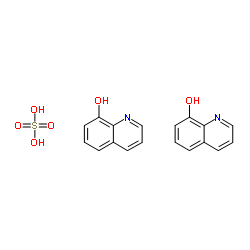8-Hydroxyquinoline hemisulfate

8-Hydroxyquinoline hemisulfate structure
|
Common Name | 8-Hydroxyquinoline hemisulfate | ||
|---|---|---|---|---|
| CAS Number | 134-31-6 | Molecular Weight | 388.394 | |
| Density | 1.26g/cm3 | Boiling Point | 267ºC at 760 mmHg | |
| Molecular Formula | C9H7NO.1/2H2O4S | Melting Point | ~175 °C | |
| MSDS | Chinese USA | Flash Point | 143.1ºC | |
| Symbol |

GHS07 |
Signal Word | Warning | |
Use of 8-Hydroxyquinoline hemisulfate8-Hydroxyquinoline hemisulfate (8-Quinolinol hemisulfate) is a monoprotic bidentate chelating agent, exhibits antiseptic, disinfectant, and pesticide properties, functioning as a transcription inhibitor. |
| Name | 8-hydroxyquinoline sulfate |
|---|---|
| Synonym | More Synonyms |
| Description | 8-Hydroxyquinoline hemisulfate (8-Quinolinol hemisulfate) is a monoprotic bidentate chelating agent, exhibits antiseptic, disinfectant, and pesticide properties, functioning as a transcription inhibitor. |
|---|---|
| Related Catalog |
| Density | 1.26g/cm3 |
|---|---|
| Boiling Point | 267ºC at 760 mmHg |
| Melting Point | ~175 °C |
| Molecular Formula | C9H7NO.1/2H2O4S |
| Molecular Weight | 388.394 |
| Flash Point | 143.1ºC |
| Exact Mass | 388.072906 |
| PSA | 149.22000 |
| LogP | 4.30880 |
| Vapour Pressure | 8.34E-14mmHg at 25°C |
| Water Solubility | >=10 g/100 mL at 19 ºC |
CHEMICAL IDENTIFICATION
HEALTH HAZARD DATAACUTE TOXICITY DATA
MUTATION DATA
|
| Symbol |

GHS07 |
|---|---|
| Signal Word | Warning |
| Hazard Statements | H302 |
| Precautionary Statements | P301 + P312 + P330 |
| Personal Protective Equipment | dust mask type N95 (US);Eyeshields;Gloves |
| Hazard Codes | Xn:Harmful |
| Risk Phrases | R22 |
| Safety Phrases | S36 |
| RIDADR | 2811 |
| WGK Germany | 1 |
| RTECS | VC8260000 |
| Packaging Group | III |
| Hazard Class | 6.1(b) |
| HS Code | 2933499090 |
| HS Code | 2933499090 |
|---|---|
| Summary | 2933499090. other compounds containing in the structure a quinoline or isoquinoline ring-system (whether or not hydrogenated), not further fused. VAT:17.0%. Tax rebate rate:13.0%. . MFN tariff:6.5%. General tariff:20.0% |
|
Selective growth-inhibitory effect of 8-hydroxyquinoline towards Clostridium difficile and Bifidobacterium longum subsp. longum in co-culture analysed by flow cytometry.
J. Med. Microbiol. 63(Pt 12) , 1663-9, (2014) The major risk factor for Clostridium difficile infection (CDI) is the use of antibiotics owing to the disruption of the equilibrium of the host gut microbiota. To preserve the beneficial resident pro... |
|
|
Translating clinical findings into knowledge in drug safety evaluation--drug induced liver injury prediction system (DILIps).
J. Sci. Ind. Res. 65(10) , 808, (2006) Drug-induced liver injury (DILI) is a significant concern in drug development due to the poor concordance between preclinical and clinical findings of liver toxicity. We hypothesized that the DILI typ... |
|
|
Developing structure-activity relationships for the prediction of hepatotoxicity.
Chem. Res. Toxicol. 23 , 1215-22, (2010) Drug-induced liver injury is a major issue of concern and has led to the withdrawal of a significant number of marketed drugs. An understanding of structure-activity relationships (SARs) of chemicals ... |
| 8-Quinolinol, sulfate (2:1) (salt) |
| MFCD00013095 |
| Bis(8-hydroxyquinolinium) sulphate |
| 8-hydroxyquinoline sulphate |
| 8-Quinolinone Sulfate Monohydrate |
| EINECS 205-137-1 |
| Oxyquinoline Sulfate |
| 8-Hydroxyquinoline hemisulfate salt |
| 8-Quinolinol hemisulfate salt |
| Chinosol |
| bis(8-hydroxyquinolinium) sulfate |
| 8-Quinolinol sulfate (2:1) |
| 8-Hydroxyquinoline Sulfate Monohydrate |
| Quinolin-8-ol sulfate (2:1) |
| Quinolin-8-ol sulfate |
| Oxine Sulfate Monohydrate |
| bis(8-hydroxyquinolin-1-ium) sulfate |
| Chinosol Monohydrate |
| 8-quinolinol sulfate (2:1) (salt) |
| Hydroxyquinoline sulfate |
| 8-Quinolinol Sulfate Monohydrate |
| 8-Hydroxyquinoline sulfate |

